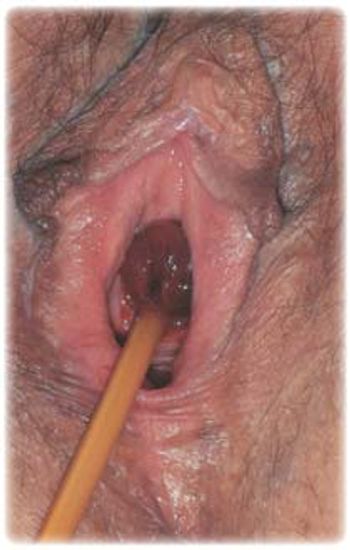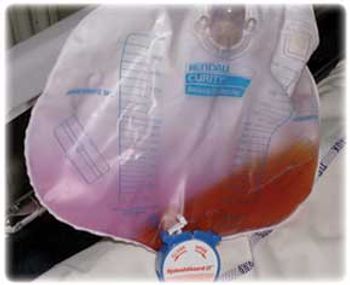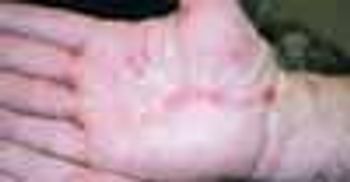
MADRID -- Lung function of Medicare-age patients, as measured by standard spirometry, can suggest how likely they are to develop dementia in the next five to six years, researchers reported here.

MADRID -- Lung function of Medicare-age patients, as measured by standard spirometry, can suggest how likely they are to develop dementia in the next five to six years, researchers reported here.

BOSTON -- The modern era of anti-HIV treatment has dramatically reduced the rate of opportunistic infections among HIV-positive children and adolescents.

A 51-year-old woman is seen because of burning at the site of entry of a urethral (Foley) catheter. The catheter had been placed perioperatively for a cholecystectomy. No history of genitourinary difficulty or trauma to the area. A urine culture that revealed Escherichia coli led to a diagnosis of urinary tract infection (UTI), but the relationship between this infection and the physical finding was unclear.

A staff nurse calls the physician to see "something really bizarre-we have no idea what this is": the plastic of a urine collection bag of an 81-year-old woman has turned purple, although the urine within is more orange-brown and distinctly less odd looking. Patient has had an indwelling urethral catheter for 7 months, and this discoloration had not been noted before. Current history includes marked constipation, atrial fibrillation, and symptomatic osteoarthrosis of the hips and knees.

LONDON -- An increasingly popular surgical treatment for childhood empyema is 25% more expensive -- but no more effective -- than intrapleural fibrinolytic treatment with Abbokinase (urokinase).

LEIDEN, The Netherlands -- Noninvasive Doppler ultrasonography is superior to traditional amniocentesis for detecting severe hemolytic fetal disease in Rh-alloimmunized pregnancies, according to an international study.

PROVIDENCE, R.I. -- A man paralyzed from the neck down has been trained to control a computer cursor and manipulate robotic hands and arms through a sensor implanted into his brain, with the aid of software that converted his intentions into action.

PITTSBURGH -- Bacterial biofilms colonizing the middle ear - and not re-infections -- may be the cause of recurrent otitis media, according to investigators here.

DALLAS -- Treatment with one month of an antiviral drug before birth significantly reduces the need for a Cesarean among women with chronic genital herpes, found investigators here.

VALENCIA, Spain -- With a combination of pegylated interferon and Rebetol (ribavirin), liver transplant recipients with recurrent hepatitis C (HCV) infection respond as well as non-transplants patients, researchers here reported.

ADANA, Turkey - Illicit anabolic steroids may pump up athletes' gums as well as their muscles, according to periodontists here.

ATLANTA - In the wake of the mass Gulf Coast evacuation from Hurricane Katrina, the most common health condition treated in evacuation centers was chronic disease while injury was the most common problem reported in health-care facilities.

NASHVILLE, Tenn. - Nearly one in every 1,000 pre-schoolers is hospitalized for influenza every year and the rate is more than four times higher for children six months or younger.

A 17-year-old boy hashad severe pharyngitis, fever, anddysphagia for the past 2 days. Althoughhe took an NSAID and triedgargling with hydrogen peroxide, heobtained no relief.

What is the next step when a patient’s urine culture shows -hemolytic streptococci?

A 49-year-old man presented to theemergency department (ED) andcomplained of fever and cough thatproduced bloody sputum for 1 day.He had AIDS and recently receiveda diagnosis of large B-cell lymphoma.His most recent CD4+ cellcount was 24/µL. He had optedagainst receiving highly active antiretroviraltherapy and prophylaxisfor opportunistic infection.

Abstract: Elderly persons with active tuberculosis may present with the classic features, such as cough, hemoptysis, and fever, but some patients present with less typical signs, such as hepatosplenomegaly, liver function abnormalities, and anemia. A high index of suspicion is required when a patient presents with cough or pneumonia unresponsive to conventional therapy. Acid-fast smear and mycobacterial culture of a sputum specimen are recommended for diagnosis. For an elderly patient who tests positive with purified protein derivative, 9 months of isoniazid prophylaxis is recommended. For patients who are intolerant of isoniazid or have been exposed to or infected by an isoniazid-resistant strain, rifampin single-agent preventive therapy may be an effective alternative. (J Respir Dis. 2006;27(7):307-315)

abstract: There is increasing evidence that close monitoring and early intervention lead to better outcomes in patients with cystic fibrosis. At each office visit, spirometry should be performed and sputum culture specimens should be obtained; if the patient cannot produce sputum, a throat culture can be done instead. New respiratory symptoms or other evidence of worsening lung disease should prompt antibiotic therapy, increased airway clearance, and adjunctive anti-inflammatory medication as appropriate. Close attention should be paid to the patient's diet, appetite, stooling pattern, and growth measurements. Adolescents should be given additional information about their medications and adjunctive therapies to encourage them to take on a larger role in their own care. (J Respir Dis.2006;27(7):298-305)

The authors describe a patient who presented with episodic hemoptysis and other respiratory symptoms. His chest radiograph showed a diffuse reticulonodular pattern. Bronchoscopy led to the diagnosis of pulmonary blastomycosis.

Abstract: Patients who have aspirin-exacerbated respiratory disease (AERD) usually experience upper and lower respiratory tract symptoms about 1Z|x to 2 hours after taking aspirin or another NSAID that inhibits the enzyme cyclooxygenase-1. In addition to symptoms such as nasal congestion, rhinorrhea, paroxysmal sneezing, periorbital edema, laryngospasm, and intense flushing, patients may have severe--often life-threatening--exacerbations of asthma. AERD occurs in about 10% to 20% of patients with asthma and in about 30% of asthmatic patients with nasal polyposis. However, AERD also occurs in patients who do not have any of these predispos- ing conditions. In patients with AERD, aspirin desensitization can improve asthma control, reduce the need for corticosteroids, and reduce the need for sinus surgery. (J Respir Dis. 2006;27(7):282-290)

A 37-year-old man presents with new-onset fever and abdominal pain of several days' duration. What does the PA film show, and what further action would you take to arrive at a diagnosis?

Rates of gonorrhea and chlamydial infection are highest among females 15 to 24 years old. Annual screening of all sexually active adolescents is warranted.

A painful, vesicular eruption; an asymptomatic red macule; a rapidlyspreading erythematous plaque--can you identify the disorderspictured here?

Painful, 1- to 1.5-cm macules and papules had developed on the palms and dorsal hands and wrists of a 60-year-old man 2 weeks earlier, after a deer-hunting trip. He had not seen any ticks on his skin or clothing. The lesions persisted despite self-treatment with over-the-counter topical corticosteroids. The patient had general malaise but denied fever, chills, and arthralgia. He was not taking any medications.

A review of the environmental determinants of allergic rhinitis and asthma, including house dust mites, cats, dogs, and cockroaches.